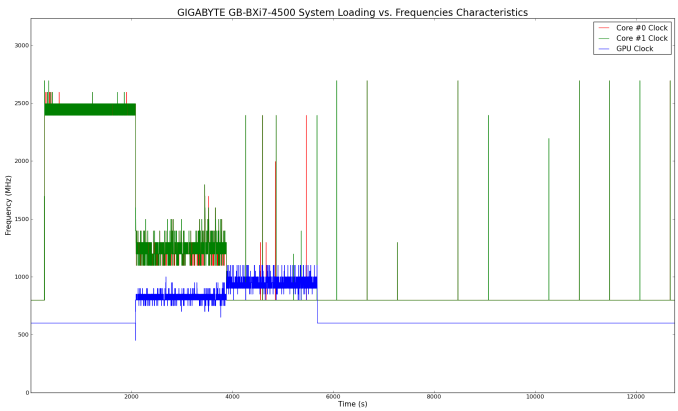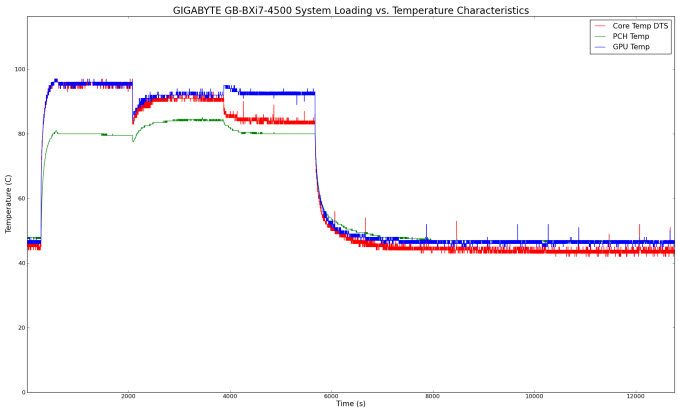GIGABYTE BRIX GB-BXi7-4500 Review: Intel Core i7 in a UCFF PC
by Ganesh T S on October 9, 2014 7:00 AM ESTPower Consumption & Thermal Performance
The power consumption at the wall was measured with a 1080p display being driven through the HDMI port. In the graphs below, we compare the idle and load power of the GIGABYTE GB-BXi7-4500 with other low power PCs evaluated before. For load power consumption, we ran Furmark 1.12.0 and Prime95 v27.9 together. The numbers are not beyond the realm of reason for the combination of hardware components in the machine.


As expected, the BXi7-4500 consumes more power at idle as well as load compared to the slightly less powerful i5-based Haswell NUCs. The ZBOX OI520 Plus ends up with a higher idle power consumption because of the hard drive inside the unit, but, otherwise, the ordering of various PCs in the above two graphs is as expected.
The evaluation of the thermal performance was performed by monitoring the various clocks in the system as well as the temperatures with the unit when subject to the following workload. We start with the system at idle, followed by 30 minutes of pure CPU loading. This is followed by another 30 minutes of both CPU and GPU being loaded simultaneously. After this, the CPU load was removed, allowing the GPU to be loaded alone for another 30 minutes.
The advertised frequencies are 1.8 GHz (to 3.0 GHz) for the CPU and 200 MHz (to 1.1 GHz) for the GPU. Under pure CPU loading conditions, the cores operate at 2.4 GHz while still managing to prevent thermal throttling. The GPU 'idles' at 600 MHz. Simultaneously loading up the CPU and the GPU pulls down the core clocks to around 1.2 GHz, with the GPU around 800 MHz. Loading only the GPU pulls up the GPU clocks to around 900 MHz with the occassioanl burst to 1.1 GHz. As the temperature graph below shows, DTS never plummets to 0, indicating that the system doesn't suffer from thermal throttling.Idlling temperatures are reached with 15 - 20 minutes of load removal, thanks to the fan inside the unit. The junction temperature of the i7-4500U is 100 C, and the fan manages to keep the temperature around 96 C under heavy loading conditions.












27 Comments
View All Comments
Shadowmaster625 - Thursday, October 9, 2014 - link
$750!!! haha. Pass it over here, man. May as well just buy a surface pro. Its not like this is a real i7 anyway. It is just an underclocked desktop i3 that occasionally runs at near stock clocks. And for that they charge $750!!!!Flunk - Thursday, October 9, 2014 - link
To get an equivalent processor in a Surface Pro 3 it would cost you $1,599.00, so I don't know what you're thinking of there.This is the same story as it always is with small form factor systems. You're paying for the size. The NUC form factor is small enough to attach to a VESA bracket. To get to that size they need to use Ultrabook components. If you want cheap pick up an AMD AM1 chip and mini-itx board or one of the little Baytrail Celeron-based mini-itx boards.
johnny_boy - Thursday, October 16, 2014 - link
You don't need ultrabook components for a vesa mountable pc. A number of mITX cases have them. And they use full sized components like ram and hardisks. The problem with todays mITX standard is that there is no appropriate small psu standard to match. SFX is till too big and pico psus require (always?) external bricks.dakishimesan - Thursday, October 9, 2014 - link
I love small ff pcs, but the mac mini is available for 599 with 2.5GHz dual-core Intel Core i5 (Turbo Boost up to 3.1GHz) with 3MB L3 cache, or 799 with 2.3GHz quad-core Intel Core i7 (Turbo Boost up to 3.3GHz) with 6MB L3 cache -- 35w cpus in a close size.WithoutWeakness - Thursday, October 9, 2014 - link
Mac Mini is considerably larger/heavier and can't be VESA mounted without dropping $50+ on an adapter. It certainly is a very capable machine for its size and the more powerful CPU options blow past the NUC-class devices but NUC, BRIX, and similar devices do a good job filling a niche for super-small "powerful-enough" x86 devices. I have the i5 Haswell NUC for a media center box and it's great for everything from media playback to some casual 1080p couch gaming and it's hardly bigger than my Raspberry Pi.MrCommunistGen - Thursday, October 9, 2014 - link
Also, despite the raw performance of the Mac Mini compared to dual core NUC-like devices, the Mac Mini uses IVB CPUs and come with 5400 RPM HDDs standard. I can see the former being an obstacle to some of the HTPC crowd. For the latter... I simply demand SSDs in any computer I spend any time using.dakishimesan - Thursday, October 9, 2014 - link
Yes true. I am a Mac Mini enthusiast but it is really annoying that Apple sometimes is right at the edge of new CPUs and other times is years behind. I bought the Sandy Bridge Mac Mini, the last one with the discrete GPU, when they released it about four months after Sandy Bridge became available. Interestingly, it was also one of the first computers available thunderbolt. The next year they upgraded to IVB almost immediately, but drop the discrete GPU, and this year there has been an update at all… So yes that sucks. I won't upgrading again until they get updated processors. However, one thing Apple loves is big increases in efficiency, so I would be surprised if they don't release a Broadwell Mac Mini, hopefully with an Iris pro Intel chip.And yes, the first thing I did was bust open my Mac Mini and put in a Samsung 840 pro SSD in there. But it wasn't the easiest upgrade of ever done.
Haravikk - Thursday, October 9, 2014 - link
Actually if you have a good electric drill you can easily VESA mount a Mac Mini; it's base is only plastic, you just drill the four holes in a 100mm square's corners, screw it into the back of the monitor/TV, place the Mac Mini onto the cover and twist it into position. With proper cable management the mini won't move at all once you've bound the power and video cables together plus, the power button is pressed in the locked direction, so there's no risk there.Of course, Apple won't repair your mini for you if there are holes in the cover, but you can get a spare for $25 or so if you need one. I've done this for a Mac Mini that's used quite a lot; it runs no hotter than when it just sitting on a desk. If Apple gets around to updating the Mac Mini with newer, more efficient processor options then it would be even better.
I'm currently building my own VESA mountable machine (or will be, if the processor ever arrives) with an Akasa Euler case and an i7-4790T (quad core, hyper threaded, 2.7ghz with 3.9ghz turbo boost and HD 4600 graphics). It ought to be pretty sweet; admittedly it touches £750 but that's with a 500gb mSATA SSD, 16gb RAM and that processor is overkill for most use-cases, so I could easily drop it into the $750 range with more modest components, while still trouncing the system in this article.
dakishimesan - Thursday, October 9, 2014 - link
That's a really interesting case, thanks for the heads up.Pugwash - Saturday, December 20, 2014 - link
Nice setup. What motherboard did you use?